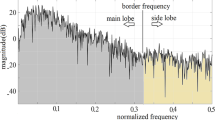Summary
A theory concerning the spectral density of surface electromyogram (EMG) in isometric contraction is described and herein, a conduction velocity measure, which was derived from a surface EMG model, is suggested. In order to confirm the validity of this measure, the spectral modification with respect to muscle fatigue is studied experimentally.
The EMG signals were obtained from the biceps brachii and the rectus femoris in four subjects. The spectral modification shifted to a lower frequency as fatigue developed. The conduction velocity measure decreased linearly in both the biceps brachii and rectus femoris, but this tendency was more pronounced in the biceps. It is suggested that the spectral shift was concerned with conduction velocity of action potential along the muscle fibres.
From these experimental results, we believe that we are justified in claiming that our conduction velocity measure is a useful index to estimate motor function.
Similar content being viewed by others
References
Agarwal G, Gottlieb G (1975) An analysis of the electromyogram by fourier, simulation and experimental techniques. IEEE Trans Biomed Eng 22: 225–229
Basmajian J, Gross G (1971) Duration of motor unit potentials from fine-wire electrodes. Am J Phys Med 50: 114–148
Buchthal F, Madsen E (1950) Synchronization activity in normal and atrophic muscle. Electroencephalogr Clin Neurophysiol 2: 426–444
DeLuca CJ, Vandyk EJ (1975) Derivation of some parameters of myoelectric signals recorded during sustained constant force isometric contractions. Biophys J 15: 1167–1180
Kadefors R, Kaiser E, Petersen I (1968) Dynamic spectrum analysis of myo-potentials and with special reference to muscle fatigue. Electromyography 8: 39–74
Kaiser E, Petersen I (1963) Frequency analysis of muscle action potentials during tetanic contraction. Electromyography 3: 5–17
Kogi K, Hakamada T (1962) Slowing of surface electromyogram and muscle strength in muscle fatigue. Rep Inst Sci Labour 60: 27–41
Kwatny E, Thomas D, Kwatny H (1970) An application of signal processing techniques to the study of myoelectric signals. IEEE Trans Biomed Eng 17: 303–312
Lindström L, Magnusson R, Petersén I (1970) Muscular fatigue and action potential conduction velocity changes studied with frequency analysis of EMG signals. Electromyography 4: 341–353
Lindström L, Kadefors R, Petersén I (1977) An electromyographic index for localized muscle fatigue. J Appl Physiol 43: 750–754
Lippold O, Redfearn J, Vuco J (1957) The rhythmical activity of groups of motor units in the voluntary contraction of a muscle. J Physiol 137: 473–487
Lloyd A (1971) Surface electromyography during sustained isometric contraction. J Appl Physiol 30: 713–719
Milner-Brown H, Stein R, Yemm R (1973a) The contractile properties of human motor units during isometric contraction. J Physiol 228: 285–306
Milner-Brown H, Stein R, Yemm R (1973b) Changes in firing rate of human motor units during linearly changing voluntary contractions. J Physiol 230: 371–390
Miyano H, Sadoyama T (1979) Theoretical analysis of surface EMG in voluntary isometric contraction. Eur J Appl Physiol 40: 155–164
Parker P, Scott R (1973) Statistics of the myoelectric signals from monopolar and bipolar electrodes. Med Biol Eng 9: 591–596
Person R, Mishin L (1964) Auto and cross-correlation analysis of the electrical activity of muscle. Med Electron Biol Eng 2: 155–159
Petrofsky J, Dahm T, Lind A (1975) Power spectrum analysis of the EMG during static exercise. Physiologist 18: 350
Petrofsky J, Lind A (1980) Frequency analysis of surface electromyogram during sustained isometric contractions. Eur J Appl Physiol 43: 173–182
Sato M (1964) Frequency components of the electromyogram led with the bipolar surface electrodes. J Anthropol Soc Nippon 72: 92–106
Sato M (1965) Some problems in the quantitative evaluation of muscle fatigue by frequency analysis of the electromyogram. J Anthropol Soc Nippon 73: 20–27
Viitasalo J, Komi P (1977) Signal characteristics of EMG during fatigue. Eur J Appl Physiol 37: 111–121
Author information
Authors and Affiliations
Rights and permissions
About this article
Cite this article
Sadoyama, T., Miyano, H. Frequency analysis of surface EMG to evaluation of muscle fatigue. Europ. J. Appl. Physiol. 47, 239–246 (1981). https://doi.org/10.1007/BF00422469
Accepted:
Issue Date:
DOI: https://doi.org/10.1007/BF00422469




